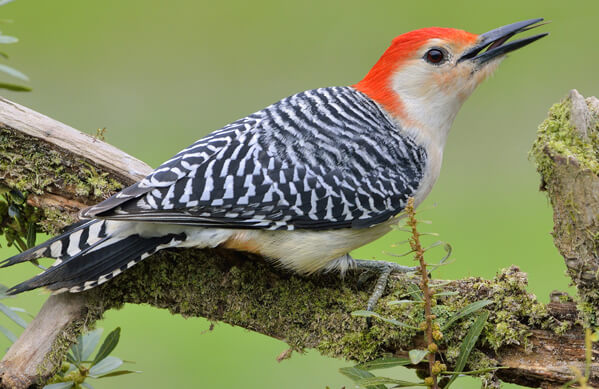Woodpeckers in Florida: Nature, Ecology, and Preservation
Woodpeckers in Florida: Nature, Ecology, and Preservation
Blog Article
Woodpeckers Unleashed: Checking Out the Marvels of These Competent Tree Climbers
Woodpeckers, with their distinctive markings and balanced drumming resembling with wooded locations, hold an one-of-a-kind location in the avian globe. Their specialized composition and adaptations allow them to navigate vertical surface areas with unmatched ability. Nevertheless, their mastery of tree climbing is just one element of their interesting habits. As we look into the intricate details of woodpeckers' nesting behaviors, feeding techniques, and the continuous preservation initiatives to safeguard these remarkable birds, a deeper appreciation for their place in nature unfolds.
Anatomy and Adaptations
When taking a look at the anatomy and adjustments of woodpeckers, one can observe remarkable functions that make it possible for these birds to thrive in their specialized ecological specific niche. Woodpeckers are outfitted with a collection of distinct anatomical attributes that assist them in their woodpecking habits. Among the most popular attributes is their strong, chisel-like beak, which is specialized for drilling right into timber to discover insects or create nesting cavities. This beak is sustained by solid neck muscular tissues and a very created skull structure that acts as a shock absorber, permitting woodpeckers to continuously eat trees without creating brain injury. Additionally, woodpeckers have zygodactyl feet, with 2 toes dealing with forward and 2 encountering backward, providing a firm grasp on tree trunks while they look for food or drum for interaction.
In addition, woodpeckers have a special tongue structure that is long, barbed, and sticky, enabling them to draw out insects from holes in wood. This specific adjustment enables woodpeckers to manipulate a food resource that is inaccessible to numerous other bird varieties. In general, the anatomy and adaptations of woodpeckers display the remarkable evolutionary services that have actually enabled these birds to flourish in their arboreal habitat.
Drumming Actions
Having actually checked out the makeup and adjustments of woodpeckers, the emphasis now shifts to understanding their drumming behavior, an unique element of their communication and territorial display screens. Drumming is a vital kind of communication among woodpeckers, serving multiple objectives such as establishing regions, bring in companions, and signaling alarm. Each woodpecker varieties has an one-of-a-kind drumming pattern that aids people acknowledge participants of their very own varieties and differentiate them from rivals or predators.
Woodpeckers produce drumming sounds by rapidly pecking on resonant surfaces such as dead trees, energy posts, or also steel things, creating a collection of balanced beats. The strength and rate of drumming can vary based upon the purpose; for circumstances, a rapid drumming series might represent aggression towards trespassers, while a slower and softer drumming pattern might show courtship (Woodpeckers in Florida). In addition, woodpeckers might adjust the regularity and duration of their drumming to communicate particular messages efficiently
Nesting Practices
Discovering the nesting behaviors of woodpeckers reveals fascinating understandings into their reproductive habits and habitat choices. Woodpeckers are recognized for their one-of-a-kind nesting choices, often digging deep into dental caries in trees to produce sheltered spaces for elevating their young. These cavities serve not just as a nesting site but additionally as a safe sanctuary from predators and inclement weather condition.
Woodpeckers display a high degree of integrity to their nesting websites, commonly returning to the exact same place year after year. This behavior highlights the importance of suitable habitat availability for their reproductive success. The option of a nesting website is essential for woodpeckers, with elements such as tree species, elevation, and degeneration phase playing significant duties in their decision-making special info process.
Interestingly, some woodpecker varieties are recognized to dig deep into several dental caries within their territory, giving themselves with alternate nesting options. This technique may work as a form of insurance versus possible threats or disturbances to their key nesting website.

Feeding Techniques
Woodpeckers employ a variety of specialized feeding methods to procure their primary food sources. Among one of the most distinctive feeding visit homepage behaviors of woodpeckers is drumming, which involves fast pecking on trees to uncover insects underneath the bark. This drumming not just assists them find victim but also offers as a means of communication with various other woodpeckers. Woodpeckers have strong, chisel-like beaks that allow them to pierce right into timber effortlessly. As soon as a hole is developed, they utilize their lengthy, barbed tongues to draw out bugs such as ants, beetles, larvae, and crawlers. These tongues are coated with sticky saliva that aids trap the prey. Woodpeckers are additionally known to dig deep into tooth cavities in trees to accessibility concealed insect larvae or sap. Some species, like the acorn woodpecker, store nuts in specially developed openings called granaries. This critical keeping of food assists them endure throughout food deficiency durations. Woodpeckers are truly amazing in their feeding methods, showcasing flexibility and intelligence in obtaining their nourishment.
Preservation Efforts
Among the complex feeding techniques showed by woodpeckers, the preservation efforts focused on securing these interesting birds play a vital role in protecting their environments and populaces. Woodpeckers deal with different hazards to their survival, including habitat loss as a result of deforestation, environment change altering their environments, and accidents with man-made frameworks such as buildings and vehicles - Woodpeckers in Florida. Preservationists are proactively working to resolve these obstacles and make certain the long-term health of woodpecker species
:max_bytes(150000):strip_icc()/GettyImages-1094628502-a831e9c1be004c05b057f488ff819127.jpg)
Education and learning and public recognition projects are also essential parts of woodpecker conservation initiatives. By elevating recognition regarding the relevance of these birds in maintaining healthy and balanced forest ecosystems, guardians can garner support for environment preservation efforts and promote liable land management techniques. With collective efforts between scientists, policymakers, and regional neighborhoods, we can collaborate to secure a future where woodpeckers thrive in their all-natural habitats.
Final Thought

Report this page